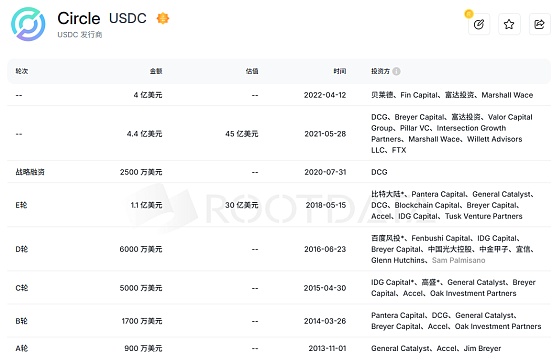The United States is vigorously promoting stablecoins, and various parties have gathered strongly, but the first to try it out is the veteranCircle.
The capital market is optimistic about it, and for the industry,Circle's listing is far more than just selling stocks.

Although luxury capital has provided escort,Circle's road to listing has not been smooth sailing. In 2018, after completing the E round of financing with a valuation of 3 billion US dollars, Circle had the initial idea of IPO, planning to stand out with "compliance + listing + transparency". But less than a year after the warm-up, the unexpected market crash in 2019 caused Circle's valuation to plummet from 3 billion to 750 million, and the IPO dream was shattered for the first time.
On May 27, Circle denied the sale rumors. On the same day, Circle formally submitted an application for listing to the New York Stock Exchange. According to the prospectus disclosed at the time, Circle issued 24 million Class A shares, of which 9.6 million shares were issued by the company and 14.4 million shares were sold by existing shareholders. The expected pricing range was US$24 to US$26 per share, and JPMorgan Chase and Citigroup would serve as lead underwriters.
But from a business model perspective,Circle has obvious hidden dangers. In terms of revenue, Circle's total revenue in 2024 is US$1.676 billion, a year-on-year increase of about 16%, of which about 99.1% of the revenue comes from interest income generated by USDC reserve assets, reaching US$1.661 billion, and other income is US$15.169 million. It can be seen that the risk-free interest rate spread is actually Circle's core source of income, but this point is obviously based on the background of macro-tightening and high interest rates. If the subsequent interest rate cut cycle is launched, its income will be affected. In other words, Circle is strongly correlated with the systemic cycle, and thus there is a possibility of systemic risk. Circleonly has 156 million US dollars, and the reason why 1.45 billion US dollars disappeared is precisely the seemingly insignificant issuance fee. Most people would think that the cost of large-scale coin issuance on the chain is infinitely close to zero, but coin issuance is zero cost. In the existing ecology, issuance is a technical job that requires a high degree of reliance on the network effect of large exchanges. Decomposing its issuance costs, Coinbase is the largest partner, and it alone has shaved off Circle's 900 million US dollars in profits, accounting for 54.18% of Circle's annual revenue. At the same time, Circle cooperated with Binance to allow USDC to participate in Binance Launchpool. The replacement cost is a one-time payment of US$60.25 million. At the same time, as long as Binance holds no less than US$1.5 billion in USDC, monthly incentives will be issued based on its USDC custody balance in the next two years. It is enough to see that in the profit structure, Circle's bargaining power is relatively insufficient, and its profits are therefore squeezed by friendly companies such as exchanges. On the other hand, Circle's obsession with listing has also caused the market to hesitate about so-called cashing out, believing that Circle's move is only to allow large capital to exit calmly, which is beneficial to Wall Street capital, rather than truly benefiting retail holders. From the current point of view, this point is still a bit thin. First, as early as 2018, Circle's valuation reached $3 billion, and the $440 million financing in 2021 was also based on a valuation of $4.5 billion. It can be considered that the valuation of most investors at the time of investment was relatively high. Therefore, although the total valuation is currently $7.2 billion, it is not a sky-high return on investment for early investors who have been running for many years. Secondly, unlike Coinbase's direct listing, Circle adopted a conventional IPO, which means that early investors and insiders cannot sell their holdings in the first 180 days, and at least in the short term, retail investors will not serve as exit liquidity. Judging from the speculation on the eve of the listing, most industry insiders believe that Circle will perform well in the context of oversubscription.
In addition, some analysts believe thatCircle's listing has also stimulated the Defi market. As Circle's valuation rises, businesses or projects closely related to stablecoins are also expected to grow. In other words,Circle may become a valuation anchor in the Defi field.
Theoretical significance is a subjective product, and the market's attitude is fundamental. Whether it is really valuable or capital cashing out,Circle's curve on the first day of listing can tell everything.
 Joy
Joy





